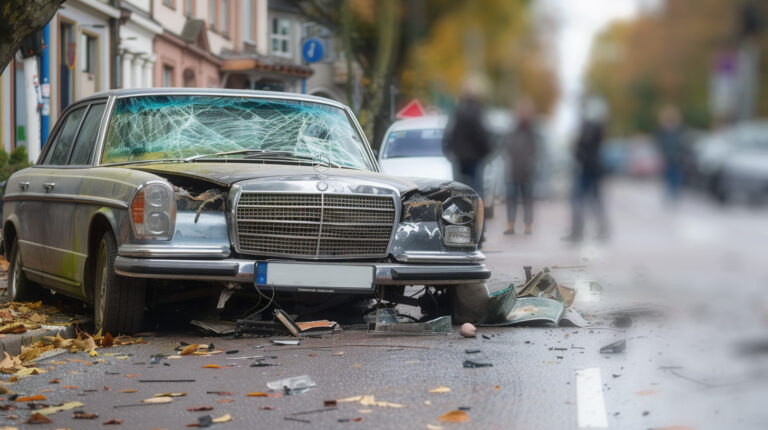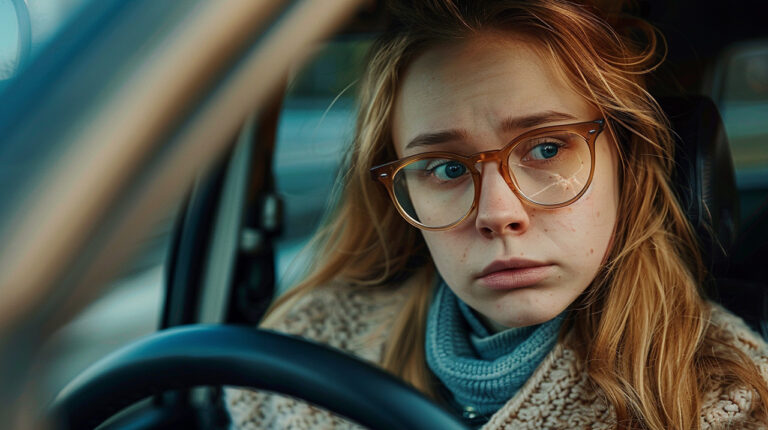A rear-end collision can happen quickly: driving too close, a quick glance at your mobile phone or the famous one-second distraction. Almost everyone knows the rule of thumb: It's always the driver's fault. But is this also true in your specific case? .
We explain both sides in our guide: When you are at fault in a rear-end collision. When you are not at fault and what you as the injured party must bear in mind in order to receive compensation, even if you are partially at fault.
- "It's always the driver's fault" may often be true, but not always!
- The question of guilt always depends on the circumstances of the individual case.
- It is therefore essential that you ensure careful documentation and inform the police in the event of disputes about fault. This can be important when it comes to settling claims.
- We will be happy to help you with your claims settlement. Even if you are partially at fault for the rear-end collision, you are covered by your motor vehicle liability insurance. Our specialists will help you enforce your claims.
Whoever crashes is always at fault - is that true?
The simple saying "If you rear-end a car, you are always at fault" is based on a similar principle in traffic law. The so-called Prima facie evidence. It is generally assumed that the person who rear-ends the car is at fault. According to this logic, the mere fact that a collision occurred proves that the person behind was following too closely. It is argued: If the distance had been large enough, the braking of the vehicle in front would not have resulted in an accident. Anyone who rear-ends a vehicle has usually not behaved with foresight in road traffic and must be held liable accordingly. So much for the theory.
In most cases, prima facie evidence can serve as a rough guide, but it is by no means a universally valid solution. If the parties involved disagree about who is at fault, the party who was hit must refute the prima facie evidence with proof.
The rule of thumb "Whoever is rear-ended is always at fault" only applies to a limited extent in the following accident constellations:
- The vehicle in front brakes hard at a green traffic light for no recognisable reason. In this case, there is usually partial culpability.
- The driver in front suddenly brakes sharply in front of a speed camera and comes to a standstill. This misleading driving behaviour also usually justifies partial culpability.
- The driver who is tailgating, who is speeding and flashing his headlights on the motorway, is at least partly to blame for this coercion.
- Even if you are looking for a parking space, recognise the parking space too late and brake sharply, causing a rear-end collision, you are usually partly at fault.
- Drivers who brake sharply because of small animals and cause a rear-end collision as a result are often found to be partially at fault. However, if it is a large animal such as a wild boar, the question of guilt is answered differently. In this case, a collision would have serious consequences for the driver and also for other road users.
For example, if the vehicle in front brakes unexpectedly and without compelling reasonhe himself commits a traffic offence in accordance with Section 4 I 2 of the Road Traffic Act and is therefore also partly to blame. The rule is that the person who intentionally or negligently violates the traffic regulations and thereby causes an accident is always at fault. The question of dispute is then: Was there a reason for the emergency braking of the vehicle in front?
Prima facie evidence in rear-end collisions
According to § 4 paragraph 1 of the Road Traffic Regulations applies:
"As a rule, the distance to a vehicle in front must be large enough to be able to stop behind it even if it brakes suddenly."
This regulation is the basis for prima facie evidence in the event of a rear-end collision: If a rear-end collision occurred, the driver was obviously in breach of duty. However, despite prima facie evidence, it is not possible to apportion blame across the board in the event of a rear-end collision: Therefore, make a detailed record of the accident and take pictures of the damage and the surrounding area. Always call the police to the scene of the accident.
What does the insurance pay in the event of a partial debt?
Even if you are partially at fault for the rear-end collision, you are covered by your motor vehicle liability insurance. However, you will not be reimbursed for the full damage - only part of it. Good news here: If you call in an expert to settle this debt quota for you according to the so-called quota prerogative, you will receive a significantly higher refund than the actual debt quota would suggest.
Example: A 50% to 50% debt distribution ratio looks like a 70:30 debt ratio in your favour in the payout result.
Special cases involving several cars: pile-ups and chain accidents
Sometimes rear-end collisions occur in which several cars are involved at the same time. We explain what you need to look out for in the event of a so-called pile-up or chain accident.
Pile-up: who pays?
Mass accidents are very often a collection of rear-end collisions. A special settlement procedure of the motor insurer then applies. If the settlement principles apply, your motor third party liability insurer will reimburse you for your claim without affecting your no-claims bonus. However, at least the following three criteria must be met for this to happen:
- The person responsible for the accident cannot be identified.
- At least 40 vehicles must be involved. In exceptional cases, 20 vehicles are also sufficient if the course of the accident is difficult to trace.
- All vehicles with a close spatial and temporal connection to the accident are involved.
Who pays in the event of a chain accident?
If you are the last to rear-end another vehicle in a chain accident, you are often fully at fault according to the prima facie evidence. The fact that you were not rear-ended by another vehicle also speaks against you. However, full blame does not necessarily have to be apportioned. The vehicle in front may have braked unexpectedly for you or come to a sudden stop by hitting the vehicle in front.
Hit a stationary car
You might think that someone who hits a stationary car is always at fault. But even here there are exceptions. If the car was not parked properly, not sufficiently lit or the collision was deliberately provoked, then the owner of the car may be partially liable.
TipSome rear-end collisions are deliberately provoked by insurance fraudsters in order to cash in. It is therefore essential that you ensure careful documentation and inform the police.
Steps towards fair claims settlement
Are you involved in a rear-end collision and wondering whether you are fully at fault? Then it's best to report it quickly to faire-Regulierung.de. The safe procedure at a glance:
- You get into a potential road accident, at least in part through no fault of your own, and want to claim compensation.
- You report the accident to us risk-free and free of charge by telephone on 0800 30 111 60 or even faster online.
- Our competent team will examine your case immediately and explain how to proceed.
- The claims settlement is initiated and you no longer have to bother with paperwork.
- You will receive the best possible compensation amount without any red tape, whether as a direct refund to your garage or a payout to you (see Fictitious settlement)
The licensed specialists from the faire-Regulierung network take care of the tasks involved and deal with your claims for compensation. You too can benefit from their experience and proven specialist knowledge.





